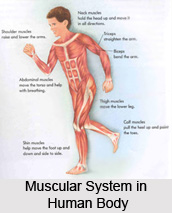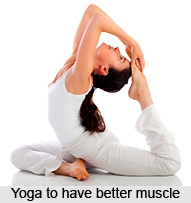 Yoga Asanas have a strengthening and toning impact on the muscular system of the human body. Yoga asanas are effective in countering problems of fitness as the practice of yoga postures improves physical health, mental peace and aids in spiritual growth.
Yoga Asanas have a strengthening and toning impact on the muscular system of the human body. Yoga asanas are effective in countering problems of fitness as the practice of yoga postures improves physical health, mental peace and aids in spiritual growth.
Muscles get stronger and well toned if yoga asanas are practiced on regular basis. Asanas reduce the fat in the abdomen and waist. All the organs and cells of the body become active, thus increasing the immunity against diseases. The muscular system consists of almost five hundred muscles. The muscles not only cover the skeleton, but also occupy the deeper parts of the human body. The `skeletal muscles` are made up of small, elongated, thread-like structures, called `muscular fibres`. The muscular coats of the stomach, the intestines and other such organs are made up of smoother muscular tissue.
When a muscle is working through yoga asanas, these tissues contract and consequently become shorter. The result is that the whole muscle is contracted and becomes shorter. When a muscle composed of fibres is at work, it not only becomes shorter but also thicker in the middle portion. This thickening of the muscle in the middle can best be felt and seen in the case of the biceps. This muscle crosses the upper arms in the front and its work is responsible for bending the forearms in the elbows. Yoga asanas strengthen the muscles of the body by effecting just such a rhythmic contraction and elongation.
Muscles that cover the skeleton bring about all the physical movements in the human body. A person can bring about any one of these movements at their own will simply because the muscles connected with these movements are under the control of the individual`s will. Thus, these muscles are called voluntary. There are other muscles, however, which cannot be contracted at the will of the individual. Their work is being done independent of the willpower and is called involuntary muscles. The best examples of involuntary muscles are those of the stomach, the intestines and the heart. The walls of arteries are also made up of involuntary muscles.

The diaphragm is perhaps the most important voluntary muscle in the human body. Being strongly built it divides the thorax from the abdomen, serving as a partition between the two. The diaphragm is a muscle that is dome-shaped, the convex surface of it being turned towards the chest. It moves up and down several times a minute and the movement increases with the practice of yoga asanas. When it descends the vertical capacity of the chest is increased, which leads to the act of inspiration. On the side of the abdomen this descent of the diaphragm exerts a tender pressure upon the abdominal viscera and gives them a kind of massage, which helps them significantly in maintaining their health. The diaphragm is not, however, the only muscle that activates respiration. There are other muscles, which co-operate with the diaphragm in carrying on the respiratory function in human beings. These muscles are situated between the ribs and hence are called inter-costal.
On the side of the belly there are a number of strong muscles, which hold together the abdominal viscera. Only two of them, the two straight muscles vertically cross the front wall of the abdomen. They are called abdominal `recti`. On the upper side they are attached to the ribs and on the lower part to the pubic bone. When they contract they give an onward bend to the body. During respiration they move in co-operation with the diaphragm, and massage the various organs held in the abdominal cavity and promote their health.
Yoga asanas are therapeutic for muscle ailments and arthritis. Some of the important asanas that cure muscle problems are Tadagasana, Pavana muktasana, Makarasana, Swastikasana, Veerasana, Trikonasana, Vrikshasana and Bhujangasana, Proper practice of these asanas, adhering to their limitations and regulations assures an immense positive effect on human muscular system.



